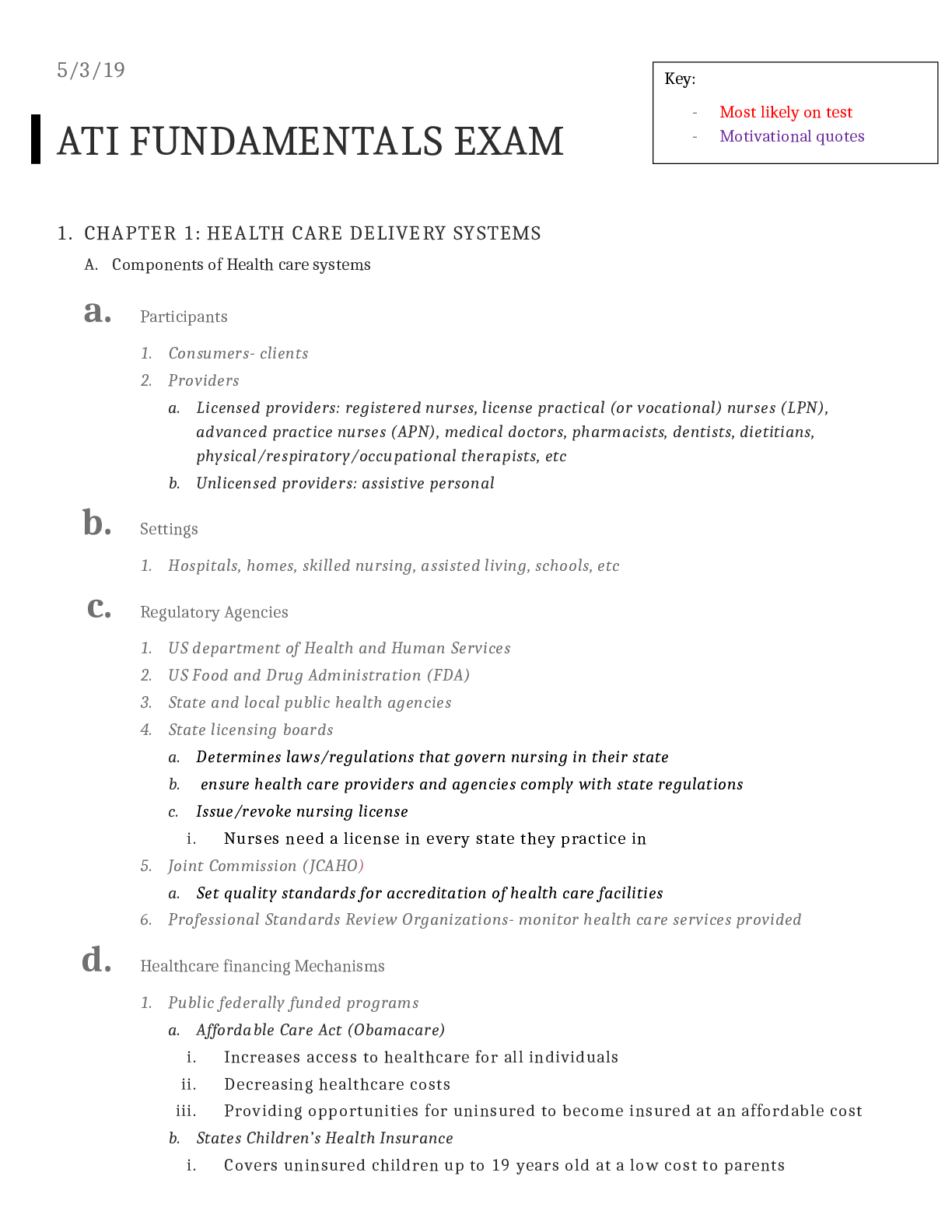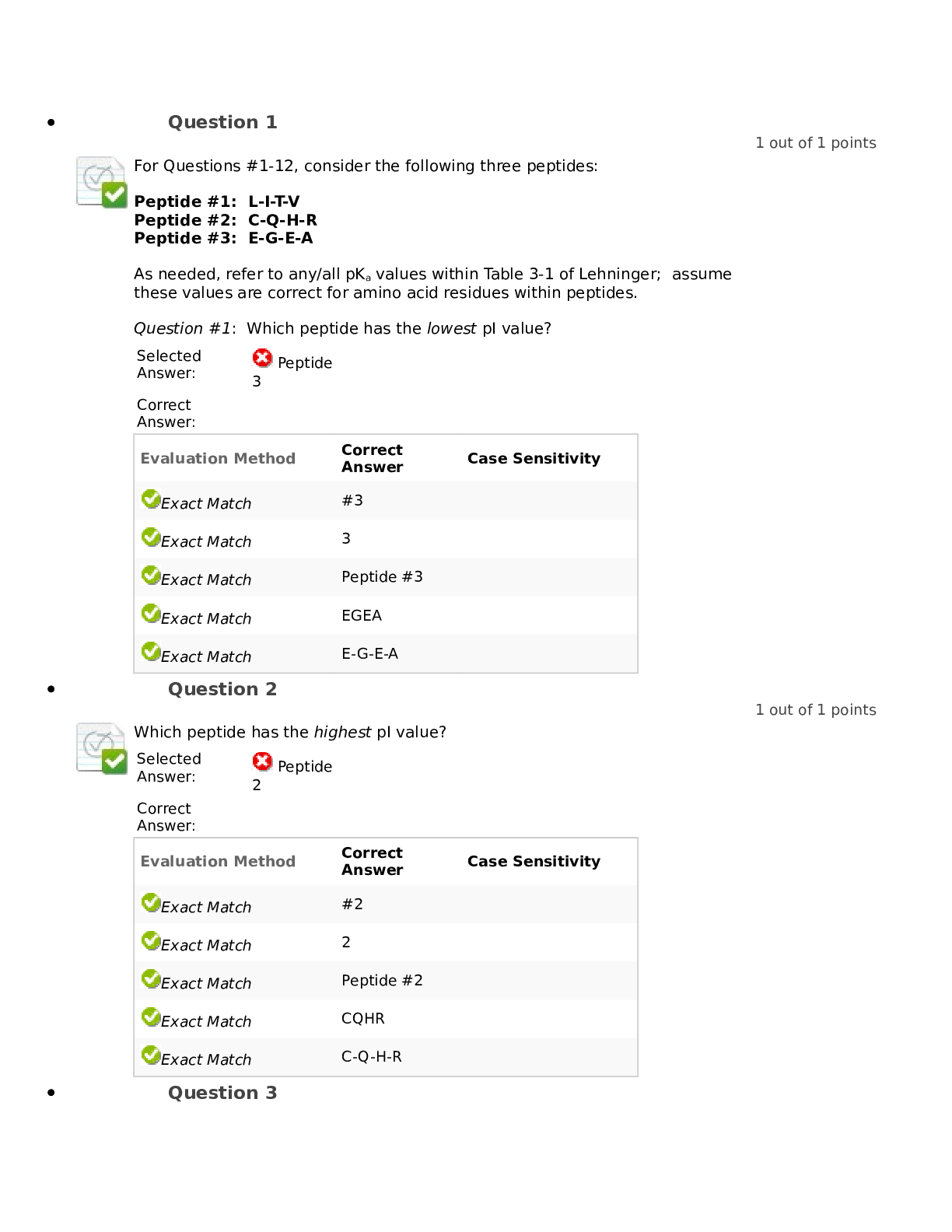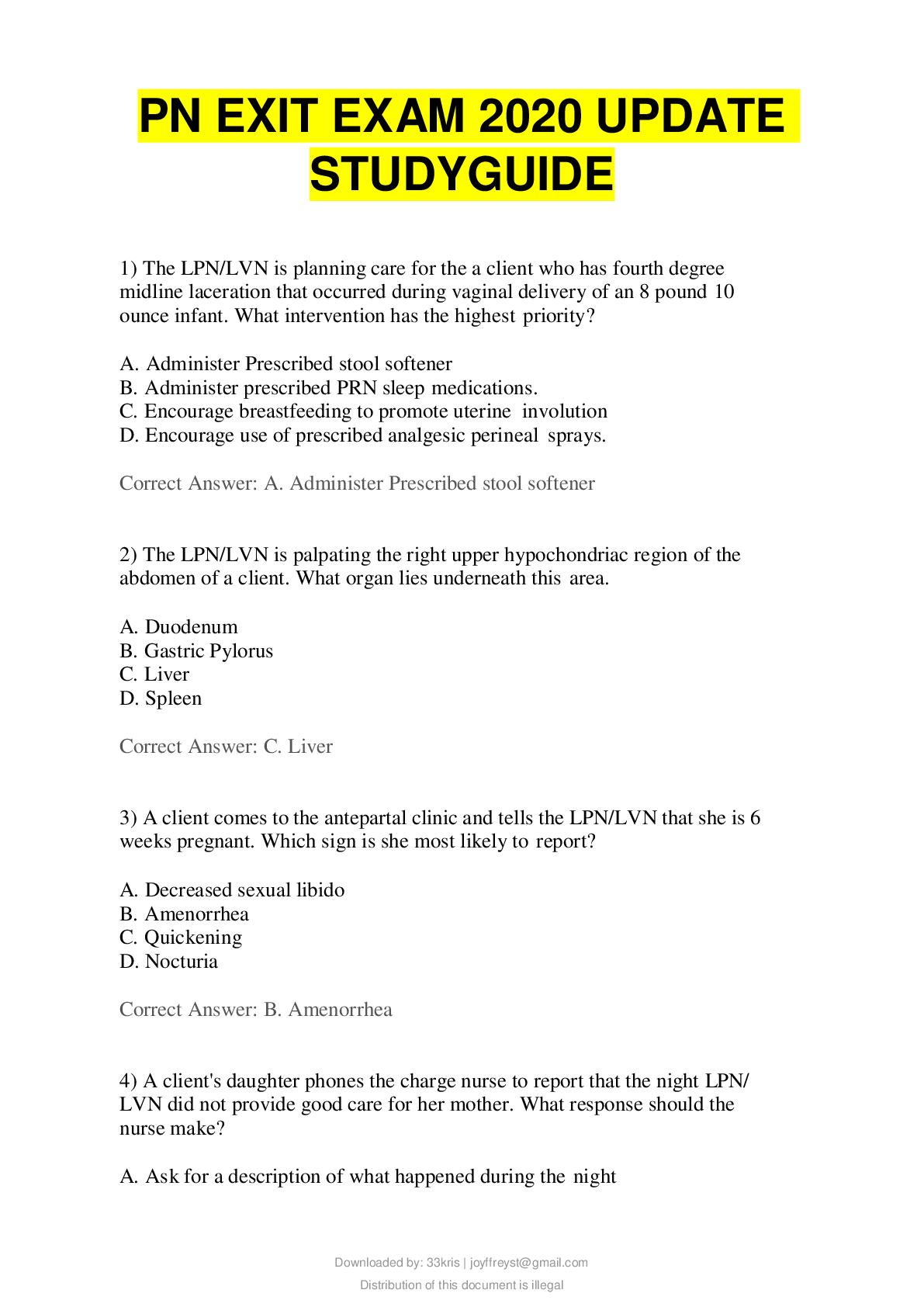ATI Fundamentals Exam 2020 (Detail Solutions and Resource for the test)
Document Content and Description Below
1. CHAPTER 1: HEALTH CARE DELIVERY SYSTEMS A. Components of Health care systems a. Participants 1. Consumers- clients 2. Providers a. Licensed providers: registered nurses, license practical (or ... vocational) nurses (LPN), advanced practice nurses (APN), medical doctors, pharmacists, dentists, dietitians, physical/respiratory/occupational therapists, etc b. Unlicensed providers: assistive personal b. Settings 1. Hospitals, homes, skilled nursing, assisted living, schools, etc c. Regulatory Agencies 1. US department of Health and Human Services 2. US Food and Drug Administration (FDA) 3. State and local public health agencies 4. State licensing boards a. Determines laws/regulations that govern nursing in their state b. ensure health care providers and agencies comply with state regulations c. Issue/revoke nursing license i. Nurses need a license in every state they practice in 5. Joint Commission (JCAHO) a. Set quality standards for accreditation of health care facilities 6. Professional Standards Review Organizations- monitor health care services provided d. Healthcare financing Mechanisms 1. Public federally funded programs a. Affordable Care Act (Obamacare) i. Increases access to healthcare for all individuals ii. Decreasing healthcare costs iii. Providing opportunities for uninsured to become insured at an affordable cost b. States Children’s Health Insurance i. Covers uninsured children up to 19 years old at a low cost to parents Key: - Most likely on test - Motivational quotesDon’t stop until you are proud c. MEDICARE MEDICAID Eligibility: >65 years old OR on disability for more than 2 years OR have ALS OR on dialysis Part A: inpatient hospital, limited skilled nursing care, home health care (hospital insurance) Part B: outpatient care, diagnostic services, OT/PT (medical insurance) Part C: combination of parts A and B, optional private insurance (Medicare advantage plan) Part D: prescription drugs (medications) Eligibility: low socioeconomic status, no insurance Federally and state funded Individual states determine eligibility requirements e. Levels of Health Care Preventati ve Focuses on educating and equipping clients to reduce or control risk factors for disease Primary Emphasizes health promotion and includes prenatal, well-baby care, family planning, nutrition counseling, disease control Secondary Diagnosis and treatment of acute illness and injury Tertiary Provision of specialized and highly technical care Restorativ e Intermediate follow-up care for restoring health and promoting selfcare Continuing Addresses long-term or chronic health care needs over a period of time 2. CHAPTER 2: THE INTERPROFESSIONAL TEAM A. Interprofessional Personnel (non-nursing) Spiritual Support Staff Provides spiritual care (pastors, rabbis, priests) Registered Dietitian Assess/plans for/educates regarding nutrition needs Laboratory technician Obtains specimens of body fluids, and performs diagnostic tests Occupational therapist Focuses on patient’s independence and regain activities of daily living (ADL) skills 2 Stay Positive, work hard, make it happenPharmacist Provides and monitors meds Physical Therapist Focuses on increasing musculoskeletal function (especially lower extremities), to maintain mobility Provider Assess/diagnose/treat diseases or injury, includes doctors, APNs, physician’s assistant Radiologic technologist Positions client and performs x rays and other imaging procedures for providers to review for diagnosis of disorders of various body parts Respiratory therapist Evaluates respiratory status and provides respiratory treatments including oxygen including oxygen therapy, chest physiotherapy, inhalation therapy, and mechanical ventilation Social worker Works with clients and families by coordinating inpatient and community resources to meet psychosocial and environmental needs that are necessary for recovery and discharge Speech-language pathologist Evaluates and makes recommendations regarding the impact of disorders or injuries on speech, languages, and swallowing Ex: patient with dysphagia call speech pathologist for consult 3. CHAPTER 3: ETHICAL RESPONSIBILITIES A. Ethical Decision Making In Nursing a. Basic principles of ethics 1. Advocacy- support of client’s health, wellness, safety, privacy, and personal rights 2. Responsibility- willingness to respect obligations and follow through on promises 3. Accountability- ability to answer for one’s own actions 4. Confidentiality- protection of privacy without diminishing access to high-quality care b. Ethical Principles for client care Autonomy The right to make one’s own personal decisions, even when those decisions might not be in that person’s best interest (ex: Jehovah’s witness- blood transfusion) Beneficence Action that promotes good for others, without any self interest Fidelity Fulfillment of promises Justice Fairness in care delivery and use of resources Nonmaleficence A commitment to do no harm Veracity Commitment to tell the truth c. Ethical Dilemma 1. Problems that involve more than one choice an [Show More]
Last updated: 2 years ago
Preview 1 out of 62 pages

Buy this document to get the full access instantly
Instant Download Access after purchase
Buy NowInstant download
We Accept:

Reviews( 0 )
$12.00
Can't find what you want? Try our AI powered Search
Document information
Connected school, study & course
About the document
Uploaded On
Apr 16, 2021
Number of pages
62
Written in
Additional information
This document has been written for:
Uploaded
Apr 16, 2021
Downloads
0
Views
66

















.png)








